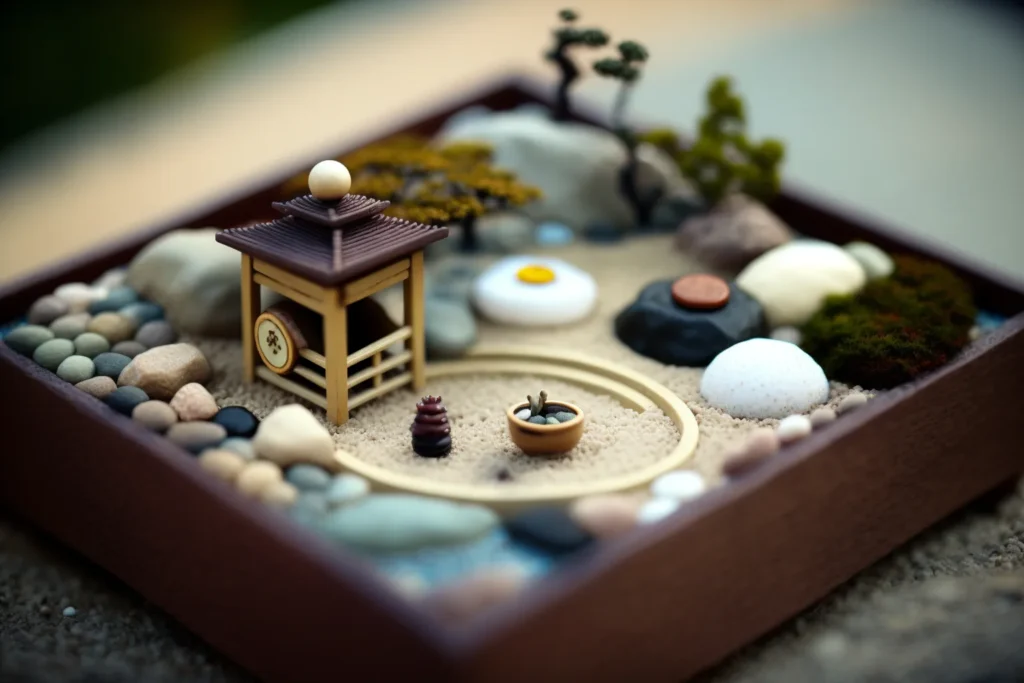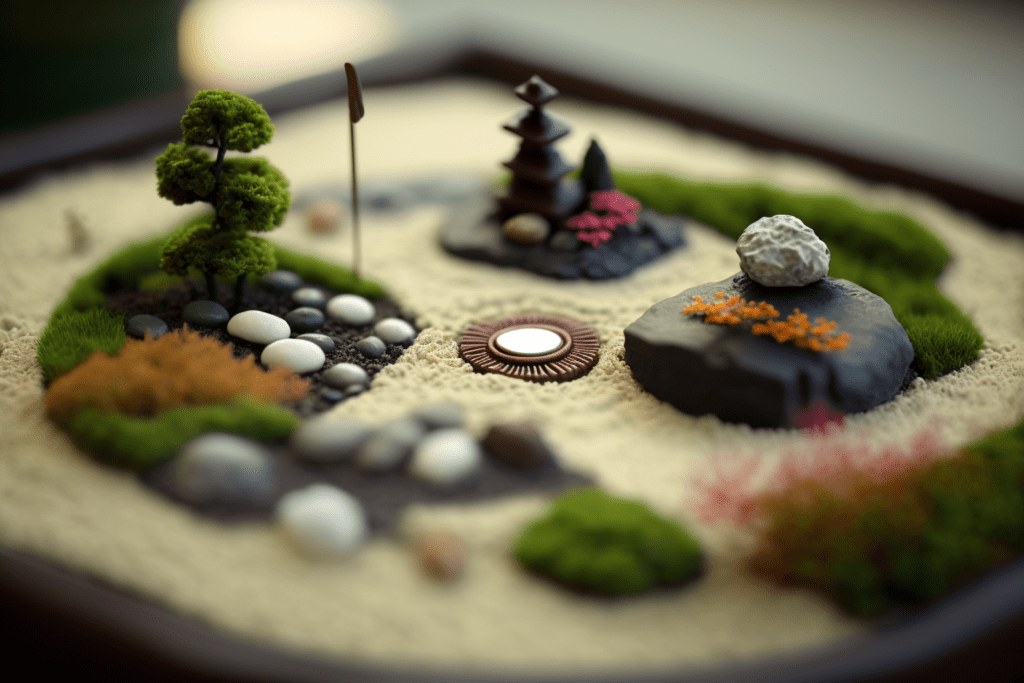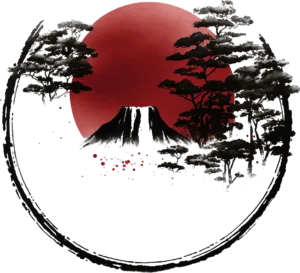
Zen Gardens have been a staple in Japanese culture for centuries. They serve as a source of serenity and tranquility, allowing individuals to escape the chaos of daily life and find inner peace. With the rise of remote work and the new normal of spending most of our days at a desk, the concept of a Zen Garden has been adapted to fit into our modern work environment. Introducing, the Japanese Zen Garden for your Desk.
A Japanese Zen Garden for your Desk is a miniature version of the traditional Zen Garden, designed specifically to fit on a desk or workspace. The purpose of having a Zen Garden is to provide a calming presence that can help reduce stress and increase focus. Whether it’s a sand garden, rock garden, or bamboo garden, these tiny landscapes offer a sense of tranquility that can help you better handle the demands of daily life.
Not only does a Zen Garden for your Desk provide a calming presence, it also offers numerous benefits. For starters, it’s a great stress-reliever. By simply gazing at the serene environment, you can help to lower your stress levels and increase focus. Additionally, it can serve as a visual representation of your progress, as you take the time to maintain and care for your Zen Garden. Finally, a Zen Garden for your Desk is an aesthetically pleasing addition to any workspace, creating a sense of harmony and balance in an otherwise chaotic environment. It really works.

Types of Desktop Japanese Zen Gardens
Japanese Zen Gardens come in many shapes and sizes, but they all serve the same purpose. Some of the most popular types include sand gardens, rock gardens, and bamboo gardens.
Sand Gardens, also known as karesansui, are a representation of the ocean and the waves. The sand is raked in patterns that symbolize the ebb and flow of water, creating a sense of balance and harmony. Sand Gardens are simple, yet elegant, and are perfect for those who want a minimalist aesthetic.
Rock Gardens, also known as kōansansui, are a collection of rocks and stones arranged in a pattern. The rocks symbolize mountains and islands, creating a serene landscape. Rock Gardens are great for those who want a more natural look and feel, as the rocks can be arranged to resemble a real-life landscape.
Bamboo Gardens, also known as takenetsumon, are a collection of bamboo stalks arranged in a vase. The bamboo symbolizes strength, resilience, and growth, creating a sense of stability. Bamboo Gardens are perfect for those who want a more organic look and feel, as the bamboo can be bent and shaped to resemble a natural landscape.
No matter what type of Zen Garden you choose, it’s important to remember that the purpose is to provide a calming presence and increase focus. Each type offers its own unique benefits and aesthetic, so choose the one that best fits your personality and style.

Miniature Zen Garden Benefits
A Zen Garden for your Desk is more than just a decoration. It’s a tool that can help you focus, reduce stress, and improve your overall well-being.
First and foremost, a Zen Garden provides a calming presence. It’s a place to escape from the chaos of daily life and to focus on the present moment. Simply gazing at the garden and moving the sand or rocks can be incredibly soothing and can help to reduce stress.
Additionally, a Zen Garden is a form of active meditation. It allows you to engage in a physical activity that requires your full attention, helping you to clear your mind and to focus on the present moment. Whether you’re working on a difficult project or just need a break from your screens, a Zen Garden is the perfect tool to help you recharge and refocus.
Lastly, a Zen Garden is a great way to improve your physical health. Many people find that they have a tendency to hold tension in their hands and arms, which can lead to a host of problems, including carpal tunnel syndrome and tension headaches. By engaging in physical activity like raking the sand or moving the rocks, you can relieve tension and improve your physical health.
A Zen Garden for your Desk is a simple, yet powerful tool that can help you to reduce stress, improve focus, and improve your physical health. It’s the perfect addition to any home or office.

Making you own Zen Garden
To start, you’ll need a container that can hold your garden, such as a shallow tray or shallow dish. Fill the container with sand or gravel, or another material that you find pleasing to the eye. You can choose to keep the material plain or you can add natural elements such as rocks or small plants.
Next, choose the elements that you would like to include in your garden. Some popular options include rakes, stones, and miniature trees. The choice is entirely up to you, but it’s important to consider how these elements will work together to create a sense of balance and harmony.
To create a Zen garden, you need to pay attention to the arrangement of elements. For example, you might place stones in a specific pattern or arrange the rakes to form lines that are pleasing to the eye. You can also play around with the height and placement of the elements to create different visual effects.
Finally, when you’re satisfied with your garden, take a moment to sit and admire it. Consider how the elements work together to create a sense of peace and balance. As you take in the beauty of your Zen garden, you may find that it helps you to release stress and focus your mind.
Creating a Zen garden for your desk is a simple way to bring a sense of calm into your daily life. With just a few elements and a bit of care and consideration, you can create a peaceful, beautiful space that you can enjoy every day.
What is the point of a mini Zen garden?
A mini Zen garden, also known as a karesansui or rock garden, serves as a symbol of peace and tranquility. It is a compact representation of the traditional Zen gardens found in Japanese temples and is designed to be used in the comfort of one’s own home. The simple yet elegant design allows for a calming escape from the hustle and bustle of daily life, inviting one to tap into their innermost thoughts and emotions.
“The Art of Raking: A Meditative Experience”
One of the defining features of a mini Zen garden is the act of raking sand or gravel into patterns. This repetitive and meditative task is not just a way of creating a visually appealing garden, but a means of fostering mindfulness. Each stroke of the rake becomes a chance to slow down, to breathe, and to let go of the worries and stress of daily life.
“A Microcosm of Serenity: The Beauty of Minimalism”
The minimalist design of a mini Zen garden is a symbol of the Buddhist philosophy of finding peace and contentment in simplicity. The small size of the garden allows one to focus on the beauty of the natural elements and their relationships with one another, such as the placement of rocks, the curves of sand, and the balance of light and shadow. In this way, a mini Zen garden serves as a microcosm of serenity and a reminder of the power of simplicity.
Overall, a mini Zen garden is more than just a decorative item, it is a tool for mindfulness, a symbol of peace, and a reminder of the beauty of simplicity. By incorporating this piece into one’s life, one can cultivate a deeper sense of relaxation, introspection, and overall well-being.

What kind of sand do you use for a Zen garden?
The type of sand used for a Zen garden can vary, with each offering its own unique aesthetic and symbolism. Some popular choices include white sand, which represents purity and peace, black sand which symbolizes stability and grounding, and gold sand that represents wealth and abundance. Other materials like crushed shells or gravel can also be used for a more natural feel, bringing a touch of the outdoors into your indoor space.
In choosing your sand, consider not only its symbolism, but also its texture and appearance. The right sand can add a calming effect to your garden, helping you find inner peace and serenity. Whether you choose the sand for its symbolism or its aesthetic, remember that the point is to create a space that reflects your personal style and brings you peace and happiness.
Is the Zen garden worth it?
Is the Zen garden worth it? That is a question as personal as the grains of sand that make up its calming landscape. For some, a mini Zen garden is a symbol of serenity, a way to find stillness in the chaos of daily life. The act of raking the sand, or rearranging the rocks, is a meditative exercise, like the gentle sway of a metronome marking the moments of peace. It’s a chance to quiet the mind and focus on the present moment, a moment that is yours and yours alone. To those individuals, the worth of a Zen garden is immeasurable.
For others, a Zen garden is simply a decoration, a lovely trinket to add some color to their desk. Its purpose may be nothing more than to be looked at and admired, but even so, it can bring a sense of calm to the surroundings, much like a peaceful river trickling by in the background. The mere sight of the garden, with its intricate patterns and balanced design, can have a calming effect, even if the act of maintaining it is not always a priority.
In the end, the worth of a Zen garden is a subjective thing, shaped by your own experiences and perspectives. Some may find it to be a worthy investment, a tool for finding peace in a busy world. Others may see it as just another trinket, something pretty to look at but ultimately meaningless. Ultimately, only you can decide if a Zen garden is worth it for you. But one thing is for certain – its simple beauty and serenity can make even the busiest day seem a little bit brighter.

Are Zen gardens Japanese or Chinese?
Zen gardens, or rock gardens, are a traditional form of Japanese garden design. While they have similarities with Chinese rock gardens, they are distinct in their aesthetic and cultural origins, rooted in the Zen Buddhist tradition of Japan. The use of raked sand and rock arrangements in Zen gardens are meant to evoke the image of natural landscapes, such as mountains and valleys, and to provide a space for meditation and contemplation. Despite their origin in Japan, Zen gardens have since been adapted and incorporated into gardens and homes around the world, allowing people from different cultures and backgrounds to experience their calming and meditative effects.
Is a Zen garden the same as a Japanese garden?
There is a delicate balance between stillness and movement in the world of gardens. A stroll through a lush, green garden may bring peace to one’s mind, while a walk along the river’s edge with its gentle, rhythmic flow may soothe the soul. But when it comes to miniature gardens, the line between a Zen garden and a Japanese garden can become blurred. While both bring a sense of serenity and simplicity, they are not the same.
A Japanese garden, with its traditional elements of water, rock formations, bridges, and carefully placed trees, is meant to create a feeling of being in nature, even in a small space. The garden may also incorporate elements such as lanterns, pagodas, and stone sculptures, all designed to evoke a sense of history and culture.
On the other hand a Zen garden is a minimalistic, abstract representation of the natural world. It typically consists of sand or gravel raked into patterns, with rocks and boulders placed strategically within the space. The simplicity of the design, combined with the act of creating and maintaining the garden, is intended to bring the mind to a state of meditation and contemplation.

Leave a Reply